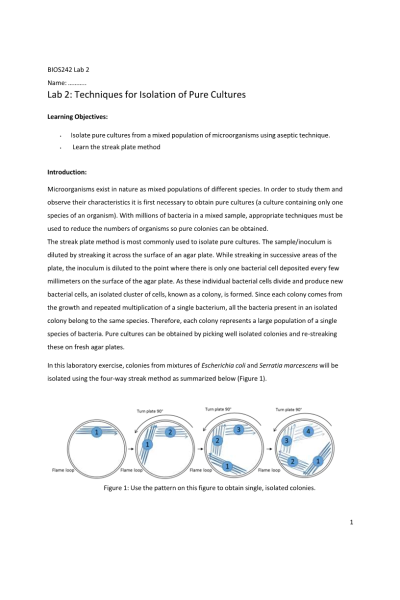BIOS 242 Week 1 Lab 2; Isolation of Pure Cultures
-
$20.00
| Institution | BIOS 242 Fundamentals of Microbiology with Lab - Chamberlain |
| Contributor | Anika Fultz |
Lab 2: Techniques for Isolation of Pure Cultures
Learning Objectives:
- Isolate pure cultures from a mixed population of microorganisms using aseptic technique.
- Learn the streak plate method
Introduction:
In this laboratory exercise, colonies from mixtures of Escherichia coli and Serratia marcescens will be isolated using the four-way streak method as summarized below (Figure 1).
Materials:
A 24 hour nutrient broth mixture of Serratia marsecens (S. marsecens) and Escherichia coli (E. coli), two nutrient agar plates per student, inoculating loops, incinerators/burners
Method: Streak Plate Method – Day 1
- Remove all extraneous materials from the lab bench and disinfect it using 10% bleach solution.
- Label the bottom of one of the nutrient agar plates with the bacteria you will be streaking, the date, and your initials or group designation.
- Obtain a nutrient broth tube containing S. marcescens and E. coli.
- Loop sterilization for those labs with reusable metal loops follow the instructions below (a and b).........
- Open the tube of broth culture. While holding the cap in your hand (do not put it down.......
- Place the sterilized inoculating loop from step 5 into the mixed bacteria culture, being careful not to touch the sides of the tube.
- Remove the inoculating loop with the bacteria sample, pass the mouth of the tube through the flame again, and cap it. You are now finished with the sample. Put it aside.
- While holding on to the inoculating loop, lift the lid of the nutrient agar plate until it forms about a 45° angle.
- Deposit your sample on the outer edge of the agar plate and use your loop to spread .....
- Metal loops only: Flame sterilize the loop. Allow to cool for approximately 10 seconds.
- Drag the loop gently through your first quadrant (only once). Continue ......
- Repeat the same procedure for quadrants 3 and 4, remembering to flame sterilize the inoculating loop between each quadrant if using metal loop.
- Metal loop only: Flame sterilize the inoculating loop prior to putting it away.
- When finished, incubate the agar plates (agar side facing upwards) at approximately 22°C (room temperature) for 24 to 48 hours.
Method: Streak Plate Method – Day 2
Part A: Identification of Individual Colonies
- Clean and disinfect your bench space using 10% bleach solution.
- Remove your plate from the incubator, seal the plates with parafilm and do not open the plates.
- Make observations using sealed plates only and study the distribution of the bacterial growth. Individual colonies should be identifiable.
- In Part A of the Lab Report, record your observations.
- You will now use this mixed culture plate for the second part of this lab.
Part B: Isolation of Pure Cultures
- Obtain a nutrient agar plate from your instructor.
- Using a marking pen, draw a line on the bottom of the plate, dividing it into two equal sections.
- Label the agar plate in each section with the bacteria you will be streaking (S. marcescens, E. coli). In addition, write the date, and your initials or group designation on the plate.
- Sterilize an inoculating loop in the flame of the gas burner and allow it to cool.
- Pick a single isolated colony from the mixed culture plate and streak it on the appropriate section of the nutrient agar plate.
- Flame sterilize the inoculating loop and repeat with an isolated colony from the other type of bacteria.
- Incubate the plates at approximately 22°C for 24 to 48 hours.
Method: Streak Plate Method – Day 3
Observe your plate and record your findings in the Lab Report.
Lab Report
Purpose: Please describe in complete sentences and in your own words, the purpose of this experiment.
Observations:
Part A: Draw the distribution and color of colonies as they appear on your plate.
Colony Description:
Part B: Draw your observations and describe the two sides of the plate. If you have individual colonies compare them to the original isolate. If not, give a general description.
S. marcescens:
E. coli:
Questions:
- Were you successful in isolating pure cultures from the mixed broth? If not, why do you think that happened? What could you have done differently?
- What was the purpose of streaking the four quadrants on the first plate? Describe the growth in each quadrant and give the reasons for this pattern.
- If there were three microorganisms in the mixture, would the streak plate method work for isolating the different bacteria? What might be some problems?
| Instituition / Term | |
| Term | Uploaded 2023 |
| Institution | BIOS 242 Fundamentals of Microbiology with Lab - Chamberlain |
| Contributor | Anika Fultz |















































